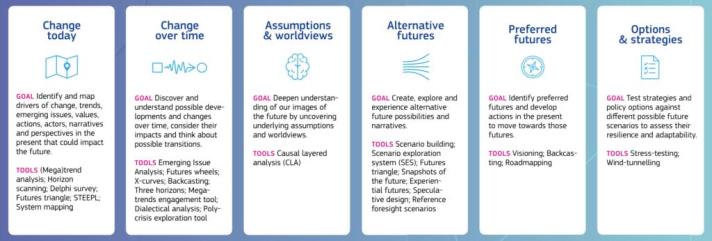
Foresight, it seems to be on everyone’s lips these days. But what is it exactly? And more importantly, how can policymakers use it in their daily work? These are the kinds of questions we at the EU Policy Lab often receive from people who are interested in foresight but are not exactly sure what it is and what it can do for them.
Where to start
To help them out, we have developed a ‘foresight menu’, for policymakers to understand and leverage foresight for more effective strategy building and decision-making. The menu describes various reasons why you would use foresight and guides the reader towards some of the tools/processes they can use. It will help policymakers clarify their starting point, their goals, and help them make the right choice about which foresight activities and processes are best suited to them.
How does it work?
Foresight - the discipline of exploring, anticipating, and shaping the future in a participatory way – can provide insights for future-oriented decision-making in many different sectors and for many different actors, not only policymakers. It seeks to navigate uncertainty and explore possible and preferable futures, not with the purpose of predicting the future, but with the intent to generate a wide variety of views on the future and understand emerging change and future possibilities.
To help anyone starting off with foresight, we first outlined the types of goals for which foresight can be used along with their corresponding foresight tools. These goals range from mapping drivers of change, understanding possible developments and changes over time to creating and exploring alternative or preferred futures and developing actions to get closer to those futures. All these foresight 'pillars' represent different steps that can be individual activities or can be part of a comprehensive foresight process.
We have also identified typical needs that are generally present in policymaking contexts, such as creating a vision, setting priorities, testing policies, or spotting risks and opportunities. The relevant foresight tools and approaches are identified for each of these policy contexts. In this way, you get a sense of both how foresight can help you reach your goals and what it can help you uncover. You can even drill down further to identify the tools and processes to be used in your particular case.
Who is it for?
Although the menu is primarily targeted at European policymakers, it is relevant for anyone interested in using foresight for future-oriented decision-making: both the needs and the foresight processes and tools are applicable in many other contexts and sectors, such as business, local policymaking, or civil society.
We hope this foresight menu can empower anyone to implement foresight in their work, to ensure visions, strategies and activities are grounded in rigorous long-term thinking.
Take a look at the menu and get in touch JRC-foresight ec [dot] europa [dot] eu (JRC-foresight[at]ec[dot]europa[dot]eu)
ec [dot] europa [dot] eu (JRC-foresight[at]ec[dot]europa[dot]eu)
Download the Foresight menu
To stay up to date with our latest news and tools, sign up to the EU Policy Lab newsletter
Details
- Publication date
- 21 February 2025
- Author
- Joint Research Centre
- EU Policy Lab tags




